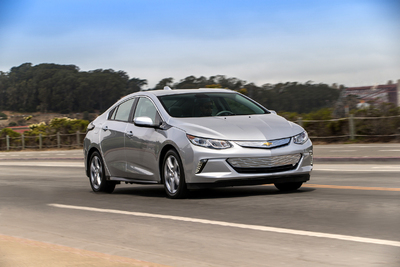2017 Chevrolet Volt Premier + VIDEO
 2017 Chevrolet Volt |
The second-generation Chevy Volt is stylish, economical, and yes, even fun to drive
DRIVING DOWN THE ROAD WITH CAREY RUSS
• SEE ALSO: Chevrolet Research and Buyers Guide
The second generation of Chevrolet’s Volt debuted for 2016, and goes into 2017 unchanged. No changes needed, as it’s lighter, more powerful, and more efficient than its predecessor, offering around 50 miles of electric-only (Electric Vehicle) range and over 400 miles total. It’s also nearly completely re-engineered and restyled.
Unlike the original, which operated as an EV when charged and then switched to hybrid gasoline-electric mode when its battery pack charge dropped below the EV threshold, EV running may be deferred in the new model to optimize efficiency.
 2017 Chevrolet Volt |
Chevrolet calls the Volt an “extended-range electric vehicle”, and others call it a plug-in hybrid. Both descriptions are correct, depending on use and charging ability. If you can charge at home and at work, especially with a 220V charging station, and work and home are within EV range, you could go a long distance between gasoline fillups. But, unlike a pure EV, when the battery charge gets too low for EV mode, the Volt reverts to hybrid operation, with its gasoline engine primarily used to charge the battery pack and run the twin electric traction motor/generator units that power the front wheels. No range anxiety — if the gas tank is only 8.9 gallons, the Volt easily gets over 40 mpg in hybrid mode. And gas stations are more common (and quicker to use) than charging stations.
Case in point: me. I live about 40 miles from the press fleet delivery service’s office. And instructed them to please defer EV mode when delivering the car, as I don’t have the ability to charge at home. No problem. When the first-generation Volt was delivered for review back in 2011, it was just about empty of EV-mode charge, and couldn’t be recharged. This time I was able to run in all modes. If you live in an older house, or a condo or apartment with limited or no garage parking, this is a major plus. Also, a gas fillup takes only a few minutes. A full charge from empty here takes 13 hours at 120V, as into an outlet in your garage, or four and a half hours at 220V. Both aren’t necessarily a problem when charging overnight at home or during work hours at the office or combing shopping with charging if the mall has charging stations. Still, I can think of better ways to spend my time than waiting a few hours for the car to charge enough to get me home.
Despite its limitations, I liked the first-generation Volt. The new one is much, much better in all respects. It’s a bit roomier inside, a couple hundred pounds lighter in weight, with more power from both the engine and motors, and is noticeably quicker in acceleration. Suspension and steering are both improved. The original felt like a high-tech device disguised as an automobile; the new Volt is a car. With an unusual drivetrain, to be sure, but a pleasant, quiet, economical car. The two trim levels are well-appointed LT and upscale Premier. My test car was a Premier, with all of the optional contemporary electronic safety features outfitted. That brought the bottom line to just over $40,000 — but, depending on where you live, there are government tax incentives and commute/carpool lane access privileges to be considered.
APPEARANCE: Sedan disguised as a coupe is a popular theme, especially with upscale Germans. With its sleek fastback body plan, the new Volt implements that look, with hatchback versatility as a plus. Low aerodynamic drag was a major design consideration, to improve efficiency. It also gives a look of performance, but without the high-drag wings and other appurtenances of contemporary race cars. There is some similarity to the first generation, but with further development. Familiar Chevy shapes and themes are apparent in the angular character lines on the hood and sides, and the twin-port, over-and-under grille, here partially blocked with textured material for looks and aero.
COMFORT: Inside, the new Volt is a bit cozy, but accommodating. The interior styling blends well with the exterior, and instruments and controls are easily visible and not overly-complex. You give up nothing important for efficiency. Yes, both front seats and the steering wheel are manually-adjustable, no electric motors involved so weight is saved. No complaint, efficiency is important here. At Premier trim level, seats and the steering wheel rim are leather, and fronts and outboard rear heated. (seat heaters weigh less than seat motors…) The steering wheel has controls for cruise, audio, and information systems, plus a “Regen on Demand” paddle for control of regenerative braking when slowing. The main instrument display is programmable, and the central touchscreen is the interface for audio, phone and smartphone integration including Apple CarPlay, navigation and traffic, weather, energy display, and vehicle settings systems.
Useful storage is found in the doors, a large glove box, and a smallish console with USB connections, a jack, and an inductive charger. Front seat comfort and support are very good. As in nearly all cars, the rear seat is contoured and best for two people, with tighter space in the center. Headroom is the limitation, figure medium (to about 5-8) ok, tall not so much. Legroom is good. The seatback folds 60/40 for cargo use. Charging cord storage has been moved to the side of the rear cargo area for better space utilization.
SAFETY: All of the required and expected safety features are included, including a rear-view camera. Structural improvements include more use of high-strength steel, reinforced rocker panel and side structures, and more efficient structural load paths in the Volt’s unibody structure. Electronic safety aids including lane-keep assist, blind-zone and rear cross-traffic monitoring, forward collision alert, and front automatic braking are optionally available.
RIDE AND HANDLING: The structural upgrades that enhance safety also mean lower weight and a more rigid structure on which to base the suspension. The suspension design is still independent MacPherson struts in front, with a torsion-beam axle in the rear. Good choice of and matching of spring and damper rates means a supple, comfortable ride, even on poor surfaces, and responsive handling without too much body motion. Steering is still electrically-assisted, but with much-improved weighting and road feel. It no longer feels like a video game controller. Four-wheel discs plus regenerative braking mean very good stopping ability, limited (as is cornering ability) by low rolling-resistance tires. Those improve fuel economy. Life is full of compromises…
PERFORMANCE: Power is supplied by the “Voltec Drive System”, which is all-new for the second generation. Details are not given other than it’s a combination of two AC synchronous permanent-magnet electric motors with a combined maximum output of 149 horsepower and 294 lb-ft of torque, an 18.4 kilowatt-hour lithium-ion battery pack (with more power from fewer cells compared to the first generation) and a 1.5-liter four-cylinder “range extender” gasoline engine with maxima of 101 hp and 103 lb-ft that primarily is used to charge the batter pack to run the electric traction motors. The battery pack weighs 405 pounds — but the whole package is 100 pounds lighter than the original, with much-improved power output characteristics. Zero-to-thirty acceleration, useful in traffic, is decreased by 19 percent, at 2.6 seconds according to GM. Likewise, 0-60 is now 8.4 seconds, as opposed to the 9.2 of the first generation. It makes a difference, especially on short onramps into fast traffic, a situation where good acceleration is a safety factor. In hybrid mode, engine vibration is nearly imperceptible. EV mode is extremely smooth and quiet — and careful attention to aerodynamics not only improves fuel economy, it also means minimal wind noise and good stability, even in strong winds. When the battery charge falls below the EV minimum, the Volt goes into hybrid mode. When fuel runs low, stop and feed it unleaded regular. Normal hybrid mode is fine for everyday use. “Sport” increases throttle sensitivity a bit. “Mountain” keeps more battery charge in reserve to help ascending long, steep grades. “Hold” reserves EV operation until the driver desires it — to maximize efficiency. Use your Volt as a hybrid on the highway, and as an EV around town.
As mentioned, mileage may vary wildly from the official figures depending on your ability to charge the car. That said, in hybrid mode and not being light on the right foot, I got the advertised 42 mpg. That went up to 48 after using up the EV-mode battery charge. Had I been able to recharge, that could have gone much higher.
CONCLUSIONS: The second-generation Chevy Volt is stylish, economical, and yes, even fun to drive.
SPECIFICATIONS
2017 Chevrolet Volt Premier
Base Price $ 37,570
Price As Tested $ 40,925
Engine Type aluminum alloy DOHC 16-valve inline 4-cylinder with variable cam phasing and direct fuel injection
Engine Size 1.5 liters / 91 cu. in.
Horsepower 101 @ 5600 rpm
Torque (lb-ft) 103 @ n/a rpm
Electric Motors permanent magnet AC synchronous Horsepower 149 @ n/a rpm (total) Torque 294 @ n/a rpm
Transmission Voltec electric drive
Battery type Li-Ion, 18.4 kWh
Wheelbase / Length 106.1 in. / 180.4 in.
Curb Weight 3543 lbs.
Pounds Per Horsepower n/a
Fuel Capacity 8.9 gal.
Fuel Requirement 87 octane unleaded regular gasoline
Tires P215/50 R17 91H m+s Michelin Energy Saver
Brakes, front/rear vented disc/solid disc plus regenerative braking, ABS, traction control, and StabiliTrak stability control standard
Suspension, front/rear independent MacPherson strut / torsion-beam axle
Drivetrain Front powertrain, front-wheel drive
PERFORMANCE
EPA Fuel Economy - miles per gallon electric / hybrid / observed 106 MPGe, 42 mpg hybrid/ 48 combined, 42 hybrid
0 to 60 mph 8.4 sec
OPTIONS AND CHARGES
Driver Confidence 1 Package — includes: Side blind zone alert with lane-change alert, read cross-traffic alert $ 495
Driver Confidence 2 Package — includes: Lane-keep assist, front automatic low-speed braking, Intellibeam headlamps, forward collision alert $ 495
Iridescent Pearl Tricoat paint $ 995
Chevrolet MyLink radio with navigation $ 495
Destination Charge $ 875


